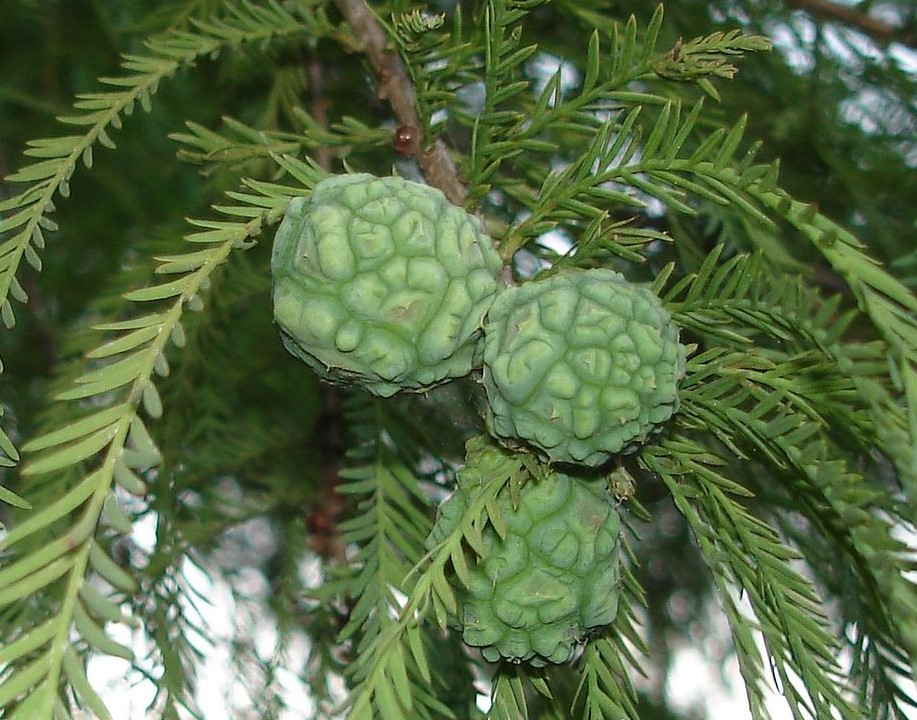Taxodium distichum

|
|
Taxodium distichum Common Names: Bald cypress, Southern cypress, Swamp
cypress, Red cypress, Gulf cypress Scientific
Classification Kingdom: Plantae Clade: Tracheophytes Phylum: Coniferophyta Class: Pinopsida Order: Pinales Family: Cupressaceae Genus: Taxodium Species: T. distichum Synonyms: Cupressus disticha L., Schubertia disticha (L.) Mirb., Cuprespinnata disticha (L.) J.Nelson, Cupressus laeta Salisb., Taxodium distichum var.
typica A.Henry Morphological Description Taxodium distichum is a large, deciduous coniferous tree, typically 30–50
meters tall, with trunk diameters of 1–3 meters, occasionally exceeding 5
meters. Its key characteristics include: · Bark: Reddish-brown to grey, fibrous, with shallow longitudinal
furrows, peeling in strips · Leaves: Feathery, needle-like, 1–2 cm long, arranged in two ranks on
slender, deciduous branchlets; bright green in spring, turning rust-brown in
autumn (Prance & Jongkind, 2015). · Cones: Globose, 2–3 cm diameter, green when young, brown and woody
at maturity, disintegrating to release seeds (Kew Science, n.d.). · Pneumatophores: Woody, conical “knees” (10–100 cm tall)
protruding from roots in wet soils, aiding gas exchange and stability Distribution and Habitat Taxodium distichum is native to the southeastern United States, with introduced
populations globally: · Geographic Range: Native to Atlantic Coastal Plain (Delaware
to Florida), Gulf Coast (Texas to Louisiana), and inland along Mississippi
River (Oklahoma to Indiana); introduced to Nigeria, Europe (UK, France), Asia
(China, Japan), and Australia; cultivated in Nigeria’s botanical gardens and
urban landscapes (Kew Science, n.d.). · Habitat: Thrives in swampy, waterlogged soils (fine sand, clay) of
wetlands, riverbanks, and coastal plains; prefers acidic soils (pH 4.5–6.5)
with constant moisture; tolerates elevations up to 100 m and 1,000–2,500 mm
annual rainfall · Ecological Role: Keystone species in wetlands, stabilizing
soils and providing habitat for birds, amphibians, and reptiles; enhances
biodiversity in cypress swamps (Burkill, 1985). Ethnopharmacology Taxodium distichum has a history of traditional medicinal use, particularly
among Native American communities, with emerging pharmacological validation
(Kusumoto et al., 2010): · Antimicrobial: In Nigeria, leaf decoctions treat skin infections. Essential
oil from leaves (α-pinene: 54.8%) inhibited Mycobacterium
tuberculosis (MIC: 1 mg/mL)
and Aspergillus fumigatus, supporting use for wound healing and respiratory infections (Chukwujekwu
et al., 2014). · Anti-inflammatory: Bark infusions are used in Nigeria for
rheumatism. Methanolic leaf extract (100 mg/kg) reduced carrageenan-induced paw
edema in rats by 40%, attributed to abietane diterpenes like taxodione
(Kusumoto et al., 2009). · Anticancer: Bark extracts are traditionally used for tumors. Taxodistine
B, a diterpene from cones, inhibited tubulin polymerization and was cytotoxic
to murine lymphoma P388 cells (IC50: 0.5 µg/mL), suggesting antitumor potential
(Hirasawa et al., 2007). · Antispasmodic and Bronchodilator: Leaf extracts treat bronchial ailments in
Native American medicine. Hydroethanolic leaf extract relaxed guinea pig
tracheal smooth muscle (EC50: 0.1 mg/mL), supporting use for asthma and
bronchitis (Cortés-Arroyo et al., 2011). · Antileishmanial: Cone extracts showed antileishmanial
activity against Leishmania donovani (IC50: 0.97 µg/mL), with 8,11,13-abietatriene-7α,18-diol as
a key compound, validating traditional use for parasitic infections (Naman et
al., 2016). · Wound Healing: Bark applied topically treats sores and burns in traditional
practices. Tannins and flavonoids in bark extracts promote tissue regeneration
and reduce microbial load, though specific studies on T. distichum are limited (Kay, 1996). ⚠ Toxicity Profile: Taxodium distichum is generally non-toxic at therapeutic
doses, with no significant human toxicity reported. Acute toxicity studies
showed no mortality in rats at leaf extract doses up to 2,000 mg/kg (LD50 >
2,000 mg/kg). High doses (>1,000 mg/kg) may cause mild gastrointestinal
discomfort or liver enzyme elevation (ALT increased by 10%). Contact with resin
or prolonged exposure to essential oil may cause skin irritation in sensitive
individuals. Use is contraindicated in pregnancy and for children due to
insufficient safety data (Ogunwande et al., 2007). Additional Uses · Timber: Rot-resistant heartwood used in Nigeria for construction,
furniture, and boat-building; highly valued for durability in moist
environments. · Ornamental: Planted in Nigerian botanical gardens and urban parks for
its aesthetic appeal and shade (Burkill, 1985). · Ecological: Used in Nigeria for wetland restoration and erosion control;
supports biodiversity in cypress swamps. · Cultural: In Native American traditions, bark and cones used in
rituals; limited cultural use in Nigeria due to introduced status (Kay, 1996). References
External Links More Pictures |
|
| Compounds of Taxodium distichum |
|
| References |